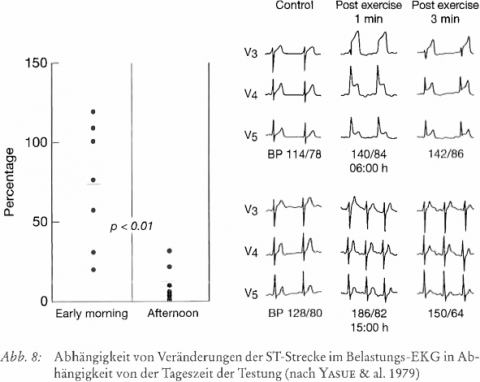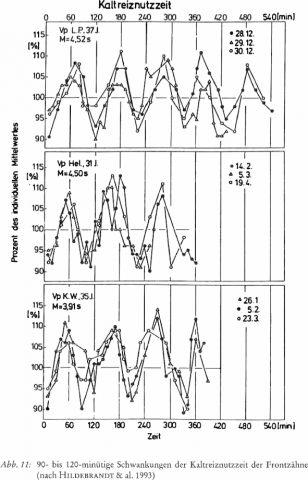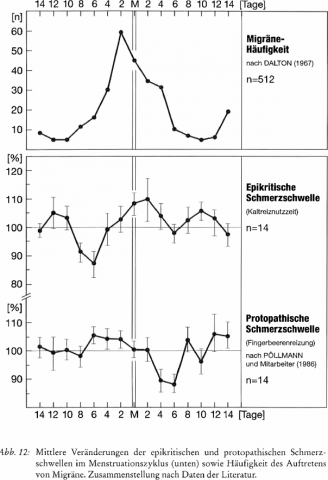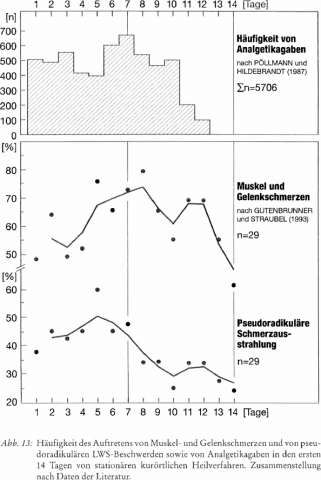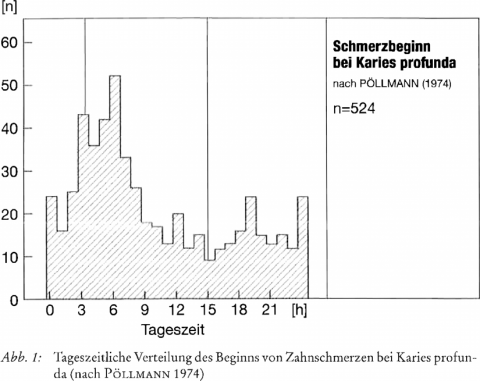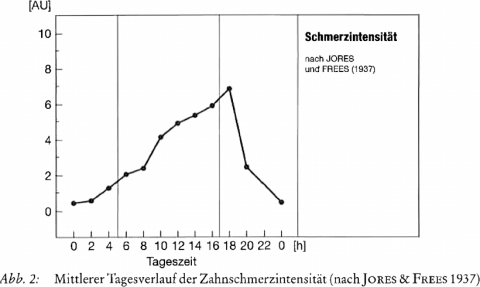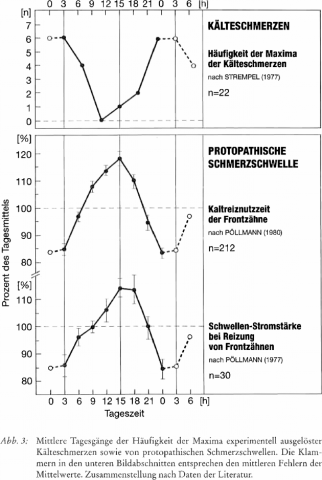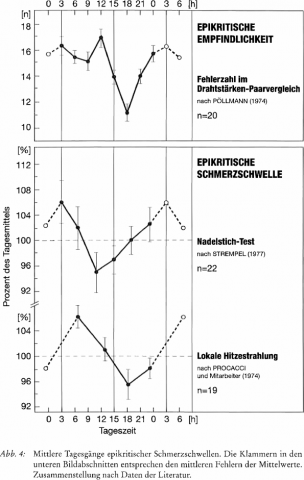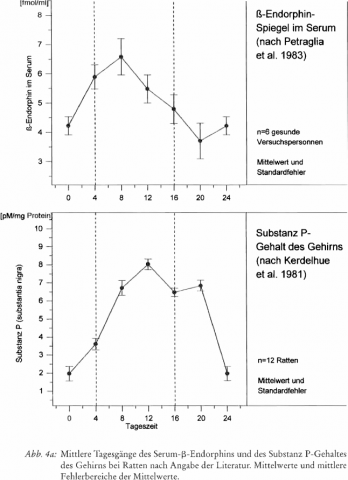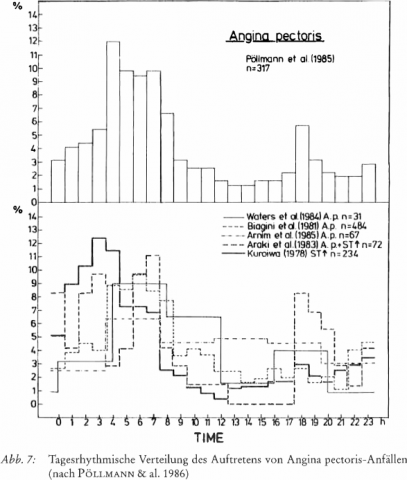Chronobiologische Aspekte der Schmerzempfindung
Export Article Citation as
- Download price : €6
Abstract:
Chronobiological aspects of pain sensation
It has been known for a long time that sensation of pain shows large variations. The first systematic investigations were carried out at the beginning of the 20th century. Principally, pain intensity can be influenced by sensitivity changes of the nociceptors in peripheral tissue and by processing of the pain signal in the central nervous system. Furthermore it is known that different qualities of pain - such as the so-called surface pain (1st pain, AB fibres) and internal pain (2ud pain, C fibres) are related to different afferences and are subjectcd to different intensity changes. Finally, changes of pain sensation are to be expected depending on variations in the pain-causing disease.
More recently, circadian changes of pain sensation have been well investigated: whereas maximum sensation of protopathic pain is at night, for epicritic pain it is during daytime. Clinical observations are available, for example for headache and pectanginous pain. The effectiveness of analgesics and the use of analgesic placebos show clear circadian influences. Moreover, ultra- and infradian variations of pain sensation are observed. Infradian pain sensation variations are mostly related to the menstrual cycle, to reactive periods of several days and to influences of the annual rhythm.
References
- ARNTZ, H. R., WILLICH, S. N., STERN, R., LINDERER, T., BRÜGGEMANN, T., KELINSKI, K. & SCHRÖDER, R. (1994): The Circadian Variation of Cardiopulmonary Disease Onset in the General Population: An Emergency Care System Perspective from Berlin. Ann. Emerg. Med. 23: 281 - 285
- AUVIL-NOVAK, S. E. (1999): The Chronobiology, Chronopharmacology, and Chronotherapeutics of Pain. Ann. Rev. Nurs. Res. 17: 133 - 153
- AUVIL-NOVAK, S. E., NOVAK, R. D. & el SANADI, N. (1996): Twenty-four Hour Pattern in Emergency Department Presentation for Sicle Cell Vaso-Occlusive Pain Crisis. Chronobiol. Int. 13: 449 - 456
- BRUERA, E., MACMILLAN, K., KUEHN, N. & MILLER, M. J. (1992): Circadian Distribution of Extra Doses of Narcotic Analgesies in Patients with Cancer Pain: A Preliminary Report. Pain 49: 311 - 314
- BRUGUEROLLE, B., GIAUFRE, E. & PRAT, M. (1991): Temporal Variations in Transcutaneous Passage of Drugs: The Example of Lidocaine in Children and in Rats. Chronobiol. Int. 8: 277 - 282
- CHIANG, H. T., LIN, S. L., KU, C. S. & LIU, C. P. (1999): Circadian and Weekly Variations in Pain Onset of Acute Myocardial Infarction. Chung Hua I Hsueh Tsa Chin 62: 334 - 340
- GÖBEL, H. & CORDES, P. (1990): Circadian Variation of Pain Sensitivity in Pericranian Musculature. Headache 30: 418 - 422
- GRABFIELD, G. P. & MARTIN, E. G. (1913): Variations in Sensory Threshold for Faradic Stimulation in Normal Human Subjects. Am. J. Physiol. 31: 300 - 315
- GUTENBRUNNER, CH. (1990): Muskeltraining und Muskelüberlastung. In: Hettinger, Th. (Hrsg.), Dokumentation Arbeitswissenschaft, Band 22, 271 S. 0. SchmidtVerlag Köln
- GUTENBRUNNER, CH. & STRAUBEL, H. (1992): On the Effect of a Clinical Rehabilitative Treatment in Patients with Chronic Low Back Pain. Eur. J. Phys. Med. Rehabil. 2: 10
- HANDWERKER, H. O. (1999): Einführung in die Pathophysiologie des Schmerzes. Springer-Verlag Berlin, Heidelberg, New York, Tokyo
- HILDEBRANDT, G. (1987): The Autonomous Time Structure and its Reactive Modifications in the Human Organism. In: Rensing, L., van der Heiden, U. & Makey, M. C. (Eds.), Temporal Disorder in Human Oscillatory Systems, pp. 160 - 175. Springer-Verlag Berlin, Heidelberg, New York, Tokyo
- HILDEBRANDT, G. (1993): Coordination of Biological Rhythms. In: Gutenbrunner, Ch., Hildebrandt, G. & Moog, R. (Eds.), Chronobiology and Chronomedicine. Basic Research and Applications, pp. 194 - 215. P. Lang Frank-fun, Berlin, Bern, New York, Paris, Wien
- HILDEBRANDT, G. (1998): Therapeutische Physiologie. In: Gutenbrunner, Chr. & Hildebrandt, G. (Hrsg.), Handbuch der Balneologie und Medizinischen Klimatologie, S. 5 - 84. Springer-Verlag Berlin, Heidelberg, New York u. a.
- HILDEBRANDT, G., PÖLLMANN, L. & STREMPEL, H. (1993): Chronobiologische Aspekte des Schmerzes. In: Stacher, A. (Hrsg.), Ganzheitsmedizin und Schmerz, S. 40 - 61. WUV Universitätsverlag Wien
- JORES, A. & FREES, H. J. (1937): Die Tagesschwankung der Schmerzempfindung. Dtsch. Med. Wschr. 63: 962 - 963
- KERDELHUE, B., PALKOVITS, M., KARTESZI, M. & REINBERG, A. (1981): Circadian Variations of Substance P, Luliberin (LH-RI I) and Thyroliberin (TRH) Contents in Hypothalamic and Extra Hypothalamic Brain Nuclei of Adult Male Rats. Brain Res. 206: 405 - 413
- KUBYNIN, A. N. & IGNATOV, I. D. ( 1998): A Comparative Evaluation of the Chronobiological Organization of Pain-Relieving Action of Analgesics. Vestn. Ross. Akad. Med. Nauk. 11:21 - 24
- LABREQUE, G. & VANIER, M. C. (1995): Biological Rhythms in Pain and in the Effects of Opioid Analgesics. Pharmacol. Then 68: 129 - 147
- LEMMER, B. (1989): Chronopharmacology, Cellular and Biochemical Interactions. Dekker New York
- MARTIN, E. G. & GRABFIELD, G. B. (1914): Variations of the Sensory Threshold for Faradic Stimulation in Normal Human Subjects: I. The Nocturnal Rhythm. Am. J. Physiol. 332 415 - 422
- OSTFELD, A. M. (1963): The Natural History and Epidemiology of Migraine and Muscle Contraction Headache. Neurology 13: 11 - 15
- PATEL, D. J., KNIGHT, C. J., HOLDRIGHT, D. R., MULCAHY, D., CLARKE, D., WRIGHT, C., PURCELL, H. & FOX, K. M. (1997): Pathophysiology of Transient Myocardial Ischemia in Acute Coronary Syndromes. Characterization by Continuous STSegmcnt Monitoring. Circulation 95: 1185 - 1192
- PELTER, M. M., ADAMS, M. G., WUNG, S. F., PAUL, S. M. & DREW, B. J. (1998): Peak Time of Occurrence of Myocardial Ischemia in the Coronary Care Unit. Am. J. Crit. Care 7: 411 - 417
- PÖLLMANN, L. (1974): Über die Tagesrhythmik der Schmerzempfindlichkeit der Zähne. Wehrmed. Mschr. 18: 142 - 144
- PÖLLMANN, L. (1977): Über spontan-rhythmische Schwankung der Schmerzschwelle. Dtsch. Zahnärztl. Zschr. 32: 180 - 182
- PÖLLMANN, L. (1980): Der Zahnschmerz. Chronobiologie, Beurteilung und Behandlung. C. HanserVerlag München, Wien
- PÖLLMANN, L. (1981): Zahnschmerzschwelle nach Placebogaben. In: Struppler, A. & Gessler, M. (Hrsg.), Schmerzforschung, Schmerzmessung, Brustschmerz, S. 139 - 142. Springer-Verlag Berlin, Heidelberg, New York
- PÖLLMANN, L. & HARRIS, P. H. P. (1978): Rhythmic Changes in Pain Sensitivity in Teeth. Int. J. Chronobiol. 5: 459 - 464
- PÖLLMANN, L. & HILDEBRANDT, G. (1986): Circadian Profiles and Circaseptan Periodicity in the Frequency of Administration of Analgetic Drugs after Oral Surgery. Ann. Rev. Chronopharmacol. 3: 429 - 432
- PÖLLMANN, L., HILDEBRANDT, G., MEHRHOFF, S. & SCHRAGE, E. (1986): Schmerzernpfindlichkeit, Vigilanzleistungen und orthostatische Regulationen im Menstruationsrhythmus. In: Szadkowski, D. (Hrsg.), Verhandlungen der Deutschen Gesellschaft für Arbeitsmedizin, Band 1, S. 131 - 136. Gentner-Verlag Stuttgart
- PÖLLMANN‚ L., LEISING, H. & STRAUER, B. E. (1986): Circadian Variations of Complaints by Patients Suffcring fom Angina Pectoris, Hypertension, and Heart Failures. In: Hildebrandt, G., Moog, R. & Raschke, F., Chronobiology and Chronomedicine, pp. 293 - 298. P. Lang-Verlag Frankfurt, New York, Paris
- PROCACCI, P., DELLACORTE, M., ZOPPI, M. & MARESCA, M. (1974): Rhythmic Changes of Cutaneous Pain Threshold in Man. Chronobiologia 1: 77 - 96
- SCHRÖDER, W (1905): Der Inductionsstrom als Diagnosticum in der zahnärztlichen Praxis. Korrespondenzblatt für Zahnärzte 34: 68 - 78
- SMOLENSKY, H. M. (1983): Aspects of Human Chronopathology. In: Reinberg, A. & Smolensky, H. M. (Eds.)‚ Biological Rhythms and Medicine. Cellular, Metabolic, Pathophysiologic and Pharmacologic Aspects, pp. 131 - 209. Springer-Verlag Berlin, Heidelberg, New York
- STREMPEL, H. (1977): Circadian Cycles of Epicritic and Protopathic Pain Threshold. J. Intcrdiscipl. Cycle Res. 8: 276 - 280
- TOFLER, G. H. & MÜLLER, J. E. (1992): Diurnal Variation and Triggers of Onset of Cardiovascular Disease. In: Schmidt, T. F. H., Engel, B. T. & Blümchen, G. (Eds.), Temporal Variations of the Cardiovascular System, pp 145 - 158. Springer-Verlag, Berlin, Heidelberg, New York u. a.
- WATERS, A. & O'CONNORS, O. (1971): Epidemiology of Headache and Migraine in Women. J. Neurolog. Neurosurg. Psychiat. 34: 148 - 153
- YASUE, H., OMOTE, S., TAKIZAWA, A., NAGAO, M., MIWA, K. & TANAKA, S. (1979): Circadian Variation of Exercise Capacity in Patients with Prinzmetal's Variant Angina: Role of Exercise-Induced Coronary Artery Spasm. Circulation 59: 938 - 948

